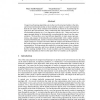Free Online Productivity Tools
i2Speak
i2Symbol
i2OCR
iTex2Img
iWeb2Print
iWeb2Shot
i2Type
iPdf2Split
iPdf2Merge
i2Bopomofo
i2Arabic
i2Style
i2Image
i2PDF
iLatex2Rtf
Sci2ools
NIPS
2007
2007
Sparse Feature Learning for Deep Belief Networks
Unsupervised learning algorithms aim to discover the structure hidden in the data, and to learn representations that are more suitable as input to a supervised machine than the raw input. Many unsupervised methods are based on reconstructing the input from the representation, while constraining the representation to have certain desirable properties (e.g. low dimension, sparsity, etc). Others are based on approximating density by stochastically reconstructing the input from the representation. We describe a novel and efficient algorithm to learn sparse representations, and compare it theoretically and experimentally with a similar machine trained probabilistically, namely a Restricted Boltzmann Machine. We propose a simple criterion to compare and select different unsupervised machines based on the trade-off between the reconstruction error and the information content of the representation. We demonstrate this method by extracting features from a dataset of handwritten numerals, and ...
Information Technology | Input | Many Unsupervised Methods | NIPS 2007 | Unsupervised Learning Algorithms |
| Added | 30 Oct 2010 |
| Updated | 30 Oct 2010 |
| Type | Conference |
| Year | 2007 |
| Where | NIPS |
| Authors | Marc'Aurelio Ranzato, Y-Lan Boureau, Yann LeCun |
Comments (0)

